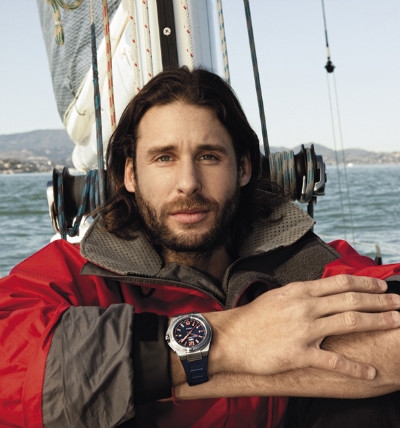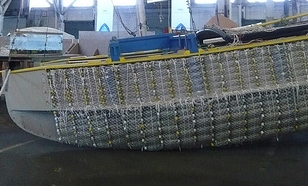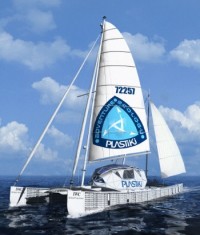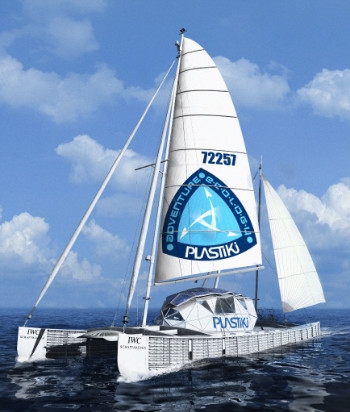 De Rothschild hopes his catamaran made of plastic bottles will draw attention to the need to develop solutions to increase the recycling and reuse of plastic.Courtesy Adventure EcologySan Francisco’s waterfront is but a Disney-fied ghost of its former life as a maritime hub. But amid the chi-chi cafés along The Embarcadero and the tourist trap faux crab shacks on Fisherman’s Wharf, some actual boat building is going on.
De Rothschild hopes his catamaran made of plastic bottles will draw attention to the need to develop solutions to increase the recycling and reuse of plastic.Courtesy Adventure EcologySan Francisco’s waterfront is but a Disney-fied ghost of its former life as a maritime hub. But amid the chi-chi cafés along The Embarcadero and the tourist trap faux crab shacks on Fisherman’s Wharf, some actual boat building is going on.
Peer through the window of a battered green door at Pier 29 ½ and you’ll see — but not hear — the form of a rather quirky catamaran quietly taking shape. That’s because it’s being built almost entirely of recyclable plastic that has been melted and molded to form hulls and bulkheads. Plastic bottles — the universal symbol of a disposable consumer culture poisoning the planet — form the pontoons and keep the boat afloat.
The Plastiki is the latest project of British environmentalist and polar adventurer David de Rothschild, the 31-year-old scion of the famous banking family. De Rothschild and his crew of five plan to set sail later this year for Sydney on a three-month voyage across the sometimes treacherous Pacific to draw attention to a host of environmental problems, from rising sea levels and coral bleaching to the Eastern Pacific Garbage Patch, a swirling mass of plastic trash twice the size of Texas.
Standing 6-feet-4-inches tall with shoulder-length brown hair and piercing eyes, de Rothschild is a media magnet — a gaggle of reporters and television cameras recently gathered for the opening of the Plastiki Mission Control Center on Pier 45 as throngs of souvenir-hunting tourists passed by a window covered in a curtain of green plastic bottles.
But the pretty-boy messenger has an unconventional message. “For a very long time, plastic has been vilified as one of those materials we say that we have to ban,” says de Rothschild, standing next to Plastiki’s equally telegenic skipper, 29-year-old ocean-racing veteran Jo Royle. “We’re looking at the Plastiki not to vilify the material but to understand it. A big part of this project is to use technology to innovate new plastics, innovate new uses. We have to move from Planet 1.0 to Planet 2.0.”
In other words, don’t outlaw plastic, but develop technological solutions to reuse, recycle and reduce. (Only 20 percent of those ubiquitous plastic water bottles are recycled, according to de Rothschild.)
The Plastiki — an homage to the Kon-Tiki, the balsa raft that took Thor Heyerdahl from South America to Polynesia in 1947 — itself is Exhibit A.
When de Rothschild’s crew at Adventure Ecology — his enviro organization — found that pontoons of plastic bottles would make the craft uncontrollable, they scoured the world for material to add structural rigidity. The answer: self-reinforcing polyethylene terephthalate (PET). PET is the stuff plastic bottles are made of but, srPET is a cloth-like material that contains plastic fibers that give it fiberglass-like strength. The cloth is heated and fused to PET foam to make panels for bulkheads and hulls. It’s all 100 percent recycled and recyclable plastic.
“You start to realize this stuff is super lightweight and super strong — this is a surfboard right here or a skateboard,” de Rothschild tells me, holding up a piece of srPET. “It’s a new type of material we are engineering. That helps us not only to achieve our project but has the ability to change an industry. Not just the naval industry but many other industries.”
 Look closely and you can see the plastic bottles that will make the Plastiki’s two pontoons float.Photo courtesy ekornblut via Flickr.“Imagine if you start changing business models,” he adds, standing on a floor made of recycled Nike athletic shoes. “What if I as a company own your surfboard and you own the graphics that cover it. So every time your board gets damaged, you bring back to us and we’ll give you a new recycled board and you buy new graphics. So you never really are having to generate new waste.”
Look closely and you can see the plastic bottles that will make the Plastiki’s two pontoons float.Photo courtesy ekornblut via Flickr.“Imagine if you start changing business models,” he adds, standing on a floor made of recycled Nike athletic shoes. “What if I as a company own your surfboard and you own the graphics that cover it. So every time your board gets damaged, you bring back to us and we’ll give you a new recycled board and you buy new graphics. So you never really are having to generate new waste.”
De Rothschild, who comes across as charming and self-effacing, declined to say what the mission will cost, citing confidentiality agreements with Plastiki’s sponsors, but he indicated that it’s in the mid seven figures.
The launch date for the mission was been delayed twice as the team works to solve the challenge of building an all-plastic boat that can withstand a transoceanic voyage. De Rothschild will only say the Plastiki will sail out of San Francisco later in the year (presumably before the Pacific cyclone season begins). He says he expects the hulls and cabin to be completed by the end of July.
Hewlett-Packard is equipping the Plastiki with computer and communications technology and has made the engineers and researchers at its HP Labs available to the Adventure Ecology team.
“They’ve allowed us the ability to throw crazy questions at them,” says de Rothschild. “We’ll say, ‘How do we convert appliances for the boat and how do we create energy saving devices for the boat?’ and they come back and say, ‘We’ve been developing this and this’ — I’m not allowed to say what. They have this amazing thin-film solar technology they’re working on which I hope we can try to include in the boat.”
The Plastiki will feature stationary bicycles that will be used to generate electricity, a small wind turbine and “biodigestible composting” toilets.
 An artist’s rendering of the Plastiki.Courtesy Adventure Ecology“As you can imagine, electrical equipment and the washing machine-like environment we’ll be living in don’t mix too well,” says Royle, the Plastiki skipper, pointing to an HP laptop computer. “This EliteBook will be used to run most of our onboard systems and not only is it 90 percent recyclable and fits in with our message about the Plastiki, it has been designed to withstand all the crashes of life in the field.”
An artist’s rendering of the Plastiki.Courtesy Adventure Ecology“As you can imagine, electrical equipment and the washing machine-like environment we’ll be living in don’t mix too well,” says Royle, the Plastiki skipper, pointing to an HP laptop computer. “This EliteBook will be used to run most of our onboard systems and not only is it 90 percent recyclable and fits in with our message about the Plastiki, it has been designed to withstand all the crashes of life in the field.”
The catamaran’s crew will be living in a geodesic dome-like cabin and blogging and vlogging about the mission, sharing the environmental data they collect. Each crewmember will also be wearing a gadget that will monitor heart rate and other biometric data that will then be broadcast to the Web. At Plastiki Mission Control, people can use HP touchscreen computers to follow the Plastiki’s progress, learn about environmental issues and interact with the crew.
“My favorite demography is between 13 to 17 years old,” de Rothschild says. “It’s an age where kids start to make decisions, start to form their opinions. They say, ‘I can do that, I can get out there.'”
So will de Rothschild be Twittering?
“I will. I’m Twittering now.”
The Plastiki mission’s Twitter handle is @Plastiki.
Next page: Videos about the Plastiki mission >>>
A promotional video about Plastiki produced by Adventure Ecology:
Watch an interview with de Rothschild conducted by 7×7 Magazine:
Read more Green State columns by Todd Woody.



